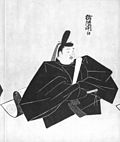Konoe Motomichi (近衛 基通, 1160 – July 8, 1233) was a Kugyō (high-ranking Japanese official) from the late Heian period to the early Kamakura period. His...
3 KB (279 words) - 20:03, 18 January 2024
1648–1722), Japanese kugyō Konoe Motomichi (近衛 基通, 1160–1233), Japanese kugyō Konoe Motosaki (近衛 基前, 1783–1820), Japanese kugyō Konoe Mototsugu (近衛 基嗣, 1305–1354)...
3 KB (452 words) - 15:02, 14 July 2018
Yorimichi called sekke: the Konoe family, Kujō family, Ichijō family, Takatsukasa family and Nijō family. Both the Konoe and Kujō families were descendants...
34 KB (1,228 words) - 07:15, 16 September 2024
Konoe Iezane (近衛 家実, 1179 – January 19, 1243), son of Motomichi, was a court noble (Kugyō) of the early Kamakura period. His sons include: Takatsukasa...
4 KB (415 words) - 18:11, 10 July 2024
the 13th century, the Fujiwara Hok-ke was split into five regent houses: Konoe, Takatsukasa, Kujō, Nijō and Ichijō. They had a "monopoly" to the offices...
25 KB (2,861 words) - 23:29, 17 October 2024
during the late Heian period. He is the founder of the Konoe family and the father of Konoe Motomichi. Motozane was born in 1143, to his father Fujiwara no...
2 KB (235 words) - 13:32, 26 September 2024
Konoe Nobutada (近衛 信尹, 1565 – 1614) was a Momoyama period Japanese courtier known as a poet, calligrapher, painter and diarist. Having no legitimate son...
4 KB (500 words) - 08:51, 13 January 2024
Prince Senior first rank Konoe Tadahiro (近衛 忠熙, September 4, 1808 – March 18, 1898), son of Motosaki, was a kugyō or Japanese court noble of the late...
3 KB (325 words) - 09:12, 4 February 2023
During Antoku's reign, this apex of the Daijō-kan included: Sesshō, Konoe Motomichi, 1160–1233. Udaijin Nadaijin, Taira Munemori, 1147–1185. Dainagon After...
13 KB (1,321 words) - 12:15, 29 October 2024
Tadamichi Konoe Motozane Fujiwara no Motofusa Konoe Motomichi Kamakura period Kujō Kanezane Konoe Motomichi Konoe Iezane Kujō Michiie Konoe Kanetsune...
1 KB (90 words) - 09:12, 4 February 2023







